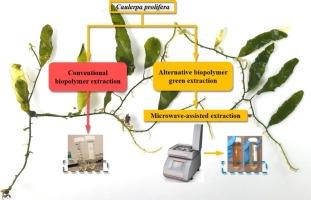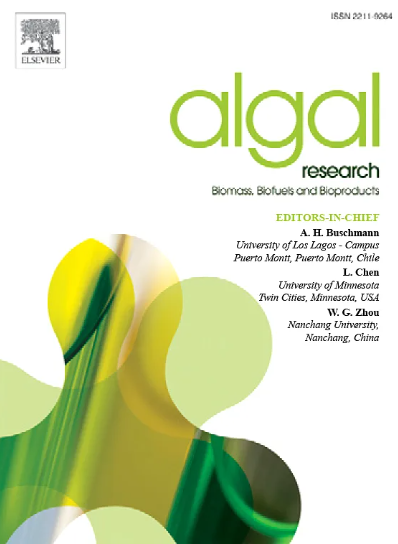微波辅助处理地中海蕨类植物溃疡并提高体外细胞活力
IF 4.5
2区 生物学
Q1 BIOTECHNOLOGY & APPLIED MICROBIOLOGY
Algal Research-Biomass Biofuels and Bioproducts
Pub Date : 2024-11-20
DOI:10.1016/j.algal.2024.103808
引用次数: 0
摘要
选择用微波处理来提取绿藻中具有胶凝和抗氧化特性的化合物。建议的微波水热条件对可溶性提取物的抗氧化特性有相关影响,在 210 ℃ 和 12 分钟时,总酚含量(80 毫克没食子酸/克提取物)和抗氧化活性(160 毫克曲环毒素/克提取物,18 毫克抗坏血酸/克提取物,IC50:234 微克/毫升)达到最高值。在 180 °C 和 6 分钟时,硫酸盐和可溶性蛋白质含量最高。在 210 ℃、3 分钟的水热处理后,多糖提取率最高。所有体系都发现了与时间无关的流体,该流体遵循幂律模型。拟议凝胶的粘弹性值(弹性模量 G′,约 500 Pa)比传统酸提取条件下获得的 G′值(约 50 Pa)高。在冷藏一个月期间未发现水滞留现象。回收率最高的 ulvan 与成纤维细胞株 929 一起进行了浓度为 0.25 至 1.0 mg/mL 的体外测试。细胞的存活率得到了证实,特别值得关注的是测试的最低浓度,它所促进的新陈代谢活性(p < 0.05)明显高于最高浓度。本文章由计算机程序翻译,如有差异,请以英文原文为准。

Microwave-assisted processing of ulvans from Mediterranean Caulerpa prolifera with in vitro cell viability
Microwave treatment was selected to extract compounds with gelling and antioxidant properties from Caulerpa prolifera green alga. The proposed microwave hydrothermal conditions had a relevant effect on the antioxidant characteristics of the soluble extracts, achieving the highest values of total phenolic content (80 mg gallic acid/g extract) and antioxidant activities (160 mg Trolox/g extract, 18 mg ascorbic acid/g extract, IC50: 234 μg/mL) at 210 °C and 12 min. The maximum of sulphate and soluble protein contents were identified at 180 °C and 6 min. The highest polysaccharide extraction were found after hydrothermal treatment at 210 °C for 3 min. Time-independent fluids following the power law model were identified for all systems. The viscoelastic values of the proposed gels (elastic modulus, G′, around 500 Pa) improved the G′ values (around 50 Pa) obtained under conventional acid extraction conditions. No water syneresis was observed during one month in cold storage. The ulvan with the highest recovery yields was subjected to in vitro tests in concentrations from 0.25 to 1.0 mg/mL with the fibroblastic cell line 929. The cell viability was confirmed, being of special interest the lowest concentration tested, which promoted a metabolic activity significantly higher (p < 0.05) than the highest ones.
求助全文
通过发布文献求助,成功后即可免费获取论文全文。
去求助
来源期刊

Algal Research-Biomass Biofuels and Bioproducts
BIOTECHNOLOGY & APPLIED MICROBIOLOGY-
CiteScore
9.40
自引率
7.80%
发文量
332
期刊介绍:
Algal Research is an international phycology journal covering all areas of emerging technologies in algae biology, biomass production, cultivation, harvesting, extraction, bioproducts, biorefinery, engineering, and econometrics. Algae is defined to include cyanobacteria, microalgae, and protists and symbionts of interest in biotechnology. The journal publishes original research and reviews for the following scope: algal biology, including but not exclusive to: phylogeny, biodiversity, molecular traits, metabolic regulation, and genetic engineering, algal cultivation, e.g. phototrophic systems, heterotrophic systems, and mixotrophic systems, algal harvesting and extraction systems, biotechnology to convert algal biomass and components into biofuels and bioproducts, e.g., nutraceuticals, pharmaceuticals, animal feed, plastics, etc. algal products and their economic assessment
 求助内容:
求助内容: 应助结果提醒方式:
应助结果提醒方式:


